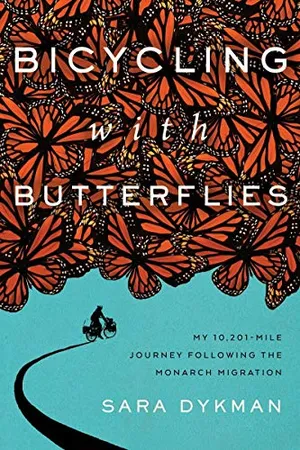The idea to bike from Mexico to Canada and back with the migrating monarch butterflies arose from a simple wish to visit them. In 2013, crossing Mexico by bike for the first time, a friend and I entertained the idea of visiting the monarchs at their overwintering sites. Because it was April and the monarchs had already begun migrating north, we decided to forego the side trip.
I spent the next few years idly daydreaming about returning. Over time, my plan morphed and grew—until I no longer wanted to just visit the migrants, but to accompany them by bicycle on their great migration. In 2016, I stopped daydreaming and picked a start date for my journey: spring of 2017. My idea was now a plan, and I had a year to work out all the details.
As with every adventure, planning was part of the fun. For a year I immersed myself in emails, web design, press releases, and business cards. I talked with scientists, clicked through websites, pored over maps, questioned my plan, and traced the vague outline of a route.
Eventually, there was nothing left to do but start. In January 2017, I braved a 52-hour bus ride from my hometown outside Kansas City, Kansas, followed by a two-day bike ride, to arrive at the parking lot of the El Rosario monarch sanctuary in Michoacán, Mexico.
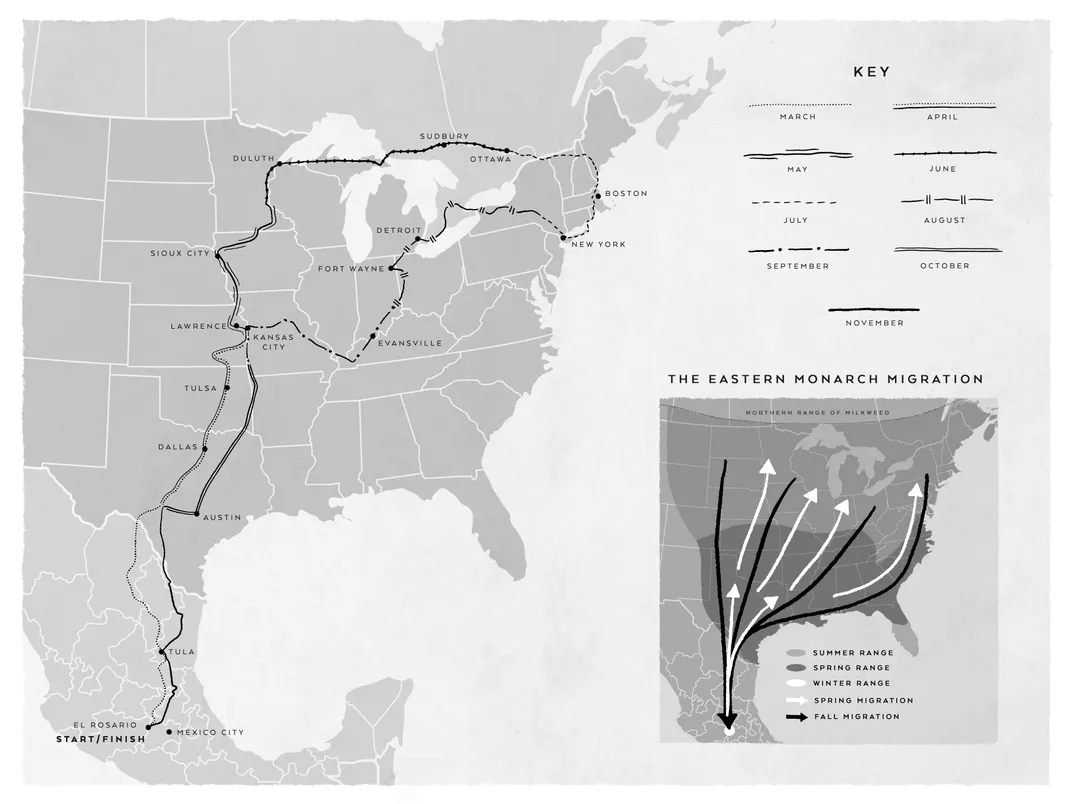
Including El Rosario, Mexico shelters between seven and 18 known overwintering monarch colonies every winter. The number varies because smaller colonies are not consistently occupied and new colonies are still being discovered. Four of the colonies are open to the public: Piedra Herrada and Cerro Pelón in the State of Mexico, and Sierra Chincua and El Rosario in the neighboring state of Michoacán.
Arriving in Mexico in January, I chose El Rosario for my first visit not only because it consistently has the most monarchs, but because it is the most accessible. I arrived at the parking lot, walked under the arched entrance, bought an entrance ticket for 50 pesos (US $2.50), and met my guide, Brianda Cruz Gonzáles. Together, we began walking up the trail.
Had it been an option, I would have opted to go alone up the mountain. But one of the rules at the overwinter sites is that visitors must be accompanied by a local guide. Most days at El Rosario there were around 70 guides waiting to lead hikers up the mountain, and 40 more waiting to take people up on horseback. Besides keeping a watchful eye on both tourists and monarchs, such work provides local economic opportunities and reduces the pressure on the mountains and forest to provide logging, mining, and cultivation jobs. The guides are a mix of young and old, men and women; it was my good chance to have been paired with Brianda. She was 26 and lived with her family at the outskirts of town, where there were more fields than houses.
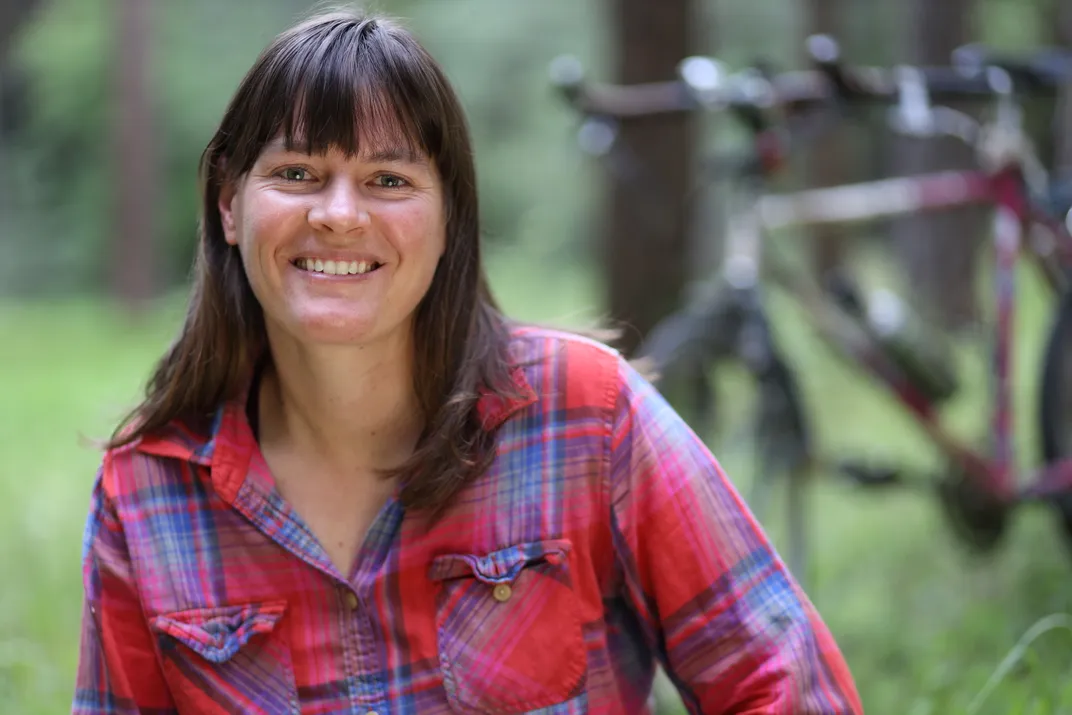
As I walked with Brianda, in the company of towering oyamel firs (Abies religiosa) and leggy, smooth-barked Mexican pines, she patiently led me down a dusty trail, forgave me for my crummy Spanish, and courteously laughed at my attempted jokes. “Respiro profundamente solo porque quiero,” I explained. We both chuckled despite the fact that my joke, “I’m only breathing hard because I want to,” wasn’t that funny. I was simply acknowledging, with a bit of self-deprecation, two truths. One: I was out of shape and breathing hard. At 10,000 feet above sea level, my Midwestern lungs craved the missing oxygen. Two: I wanted to breathe hard. I wanted to feel my body striving upward through the forest. I liked that to seek out the monarchs, one had to struggle a bit. Beautiful sights are made more beautiful by the challenge of getting there.
As if on cue, a hummingbird rocketed through the understory to investigate the long, red flowers bent toward the hazy sun. The forest was bathed in salvias: both the large, trumpet-shaped, red stalks and the smaller purple flowers. I paused to catch my breath and turned my gaze upward. I was still unsure of what millions of monarchs clustered together really looked like. All I knew was that treasures were not easy to find, and that winter’s beauty was guarded by vast space, steep mountains, and the echoes of a long-standing forest.
That forest, the last remnants of Mexico’s expansive, ancient ecosystem, caps 12 isolated massifs clustered in a volcanic mountain chain in central Mexico. After the last ice age, as temperatures increased, the oyamel fir forest that had once covered much of southern Mexico was forced to retreat to the cool, humid refuge of the mountains’ higher elevations. Once sprawling, the high-elevation oyamel holdouts now occupy less than 0.5 percent (approximately 100,000 to 124,000 acres) of Mexico. In comparison, the 2010 United States Census put Kansas City at 201,568 acres. Despite the limited area, the monarchs arrive each winter, and the oyamel fir forest absorbs nearly every monarch born between the Rocky Mountains and the Atlantic Ocean. It is a concentration of monarchs that saturates the trees and transforms the forest into the focal point of the range, an orange gem strung on a volcanic necklace.
An hour after we started hiking, Brianda signaled toward hive-like nests dangling in the branches. I stood puzzled. Then, like a stereogram image, the bundles began to define themselves. The monarchs came into focus. Their collective weight bent each branch into an archway. I stepped forward, but did not enter. Instead, I craned my neck upward to contemplate each tree shrouded in monarchs, while the monarchs, like monks, contemplated winter.
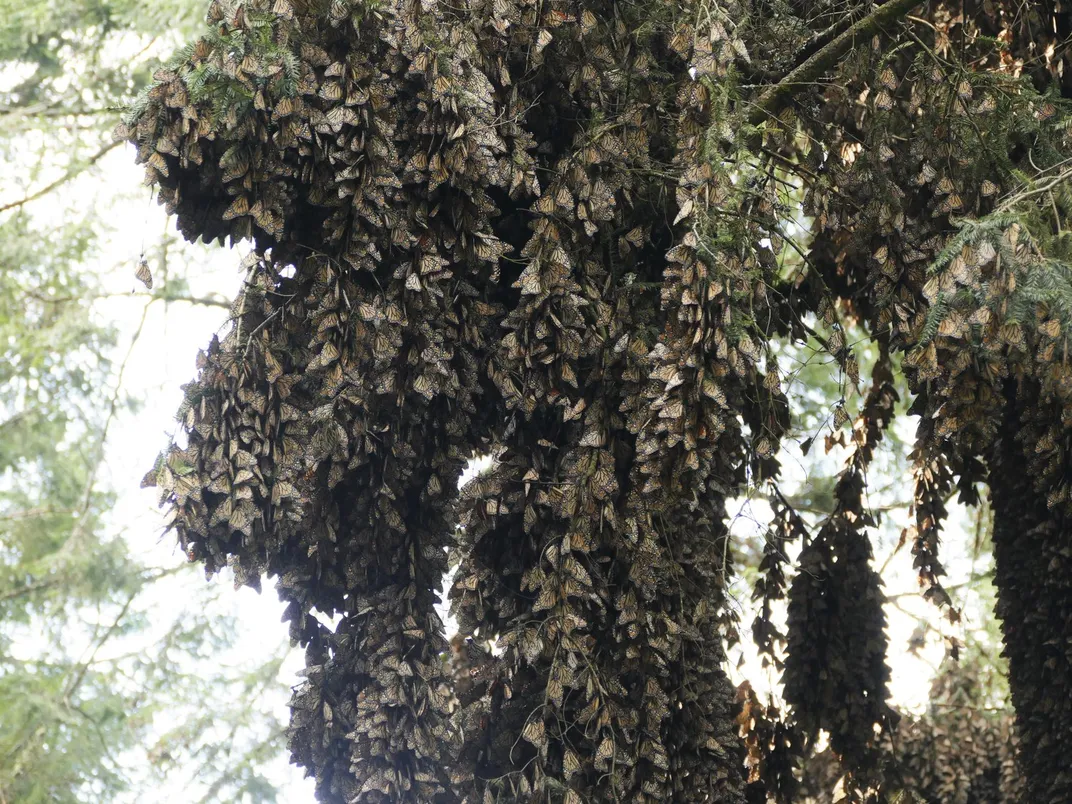
I had arrived at the start of my trip, the start of my dream: to follow the monarchs by bicycle and give voice to their alarming decline. Now I had six weeks to wait for spring to bloom and the cold grasp of winter to loosen. Even in Mexico, it had a hold.
Despite Mexico’s reputation for deserts and heat, in the high-elevation forest lit by a cloud-tangled sun, freezing storms and cold temperatures still bully the monarchs each winter. It is thanks to the protective scaffolding of the forest that the monarchs find literal and figurative sanctuary. The canopy, with its weave of branches, moderates temperatures (like a blanket) and shields precipitation (like an umbrella). The tree trunks absorb even mild heat each day, acting like warm water bottles that the monarchs can snuggle against in moments of extreme cold. At night, trunks tend to be an average of two and a half degrees Fahrenheit warmer than the surrounding ambient night temperature.
These butterflies occupy a sliver of habitat speckled with microhabitats, seemingly scripted for their survival.
It is a balance steadied by Earth’s many layers, and a balance tipped by humanity.
Each time a tree falls in the monarchs’ overwintering forest, a hole is torn in their blanket and punched through their umbrella. These disturbances—logging, disease, windstorms, fire—allow heat to escape and moisture to enter, creating a dangerous combination.
Careful with my steps, I knelt to watch a winter-battling monarch crawl toward me. I knew he was a male because of his thin, black veins and the two small, black dots (scent glands) on his hind wings. I knew he was cold, because as he crawled, he shivered.
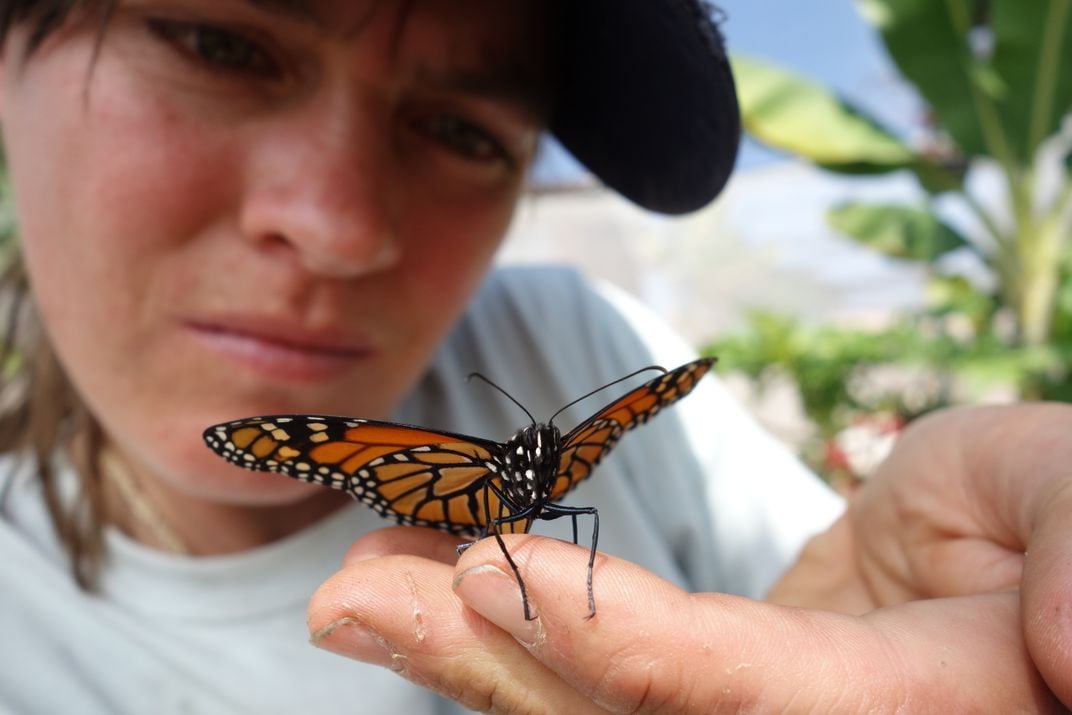
Monarchs are ectothermic (cold-blooded) animals. Their body temperature matches that of their environment. The colder the temperature, the colder monarchs get, and the more inactive they become. For much of the winter, being cold is an energetic advantage, yet, if monarchs get too cold, they risk freezing. They must employ strategies to limit exposure to the coldest extremes. For this reason, monarchs tend to occupy the sunnier, south-facing slopes of the forest, and they form clusters under the forest canopy. In such clusters, they are protected by both the trees and the butterfly bodies that make up the outer edges of each mass (a bit like penguins).
The challenges of the cold are most acute for ground-stranded monarchs. As temperatures drop, ectothermic monarchs become unable to move and can’t seek out microclimates, such as tree trunks. Monarchs must be at least 41 degrees F to crawl and 55 degrees F to fly (known as their flight threshold).
The monarch at my feet was just warm enough to crawl; he was shivering to warm his muscles to make an escape possible. Though slow, if he could climb even one foot off the ground, he could greatly increase his chances of survival. The ground held the coldest microclimates and the possibility of dew, plus the ever-present danger of black-eared mice (Peromyscus melanotis). It was a risky place for a monarch to pass the night.
But at least he was moving. I cheered him on, wishing I could offer him a cup of hot tea or a jacket. Instead, I settled on guarding him from oblivious tourists. In pantomime, I caught the attention of a group looking up, their footsteps unguarded, and reminded them to tread slower, more deliberately. Brianda, in the meantime, had found a stick, which she offered to the monarch as one might offer a hand to a dance partner. The monarch accepted. He gripped the stick, still shivering, and Brianda moved him off the trail.
Bicycling with Butterflies: My 10,201-Mile Journey Following the Monarch Migration
Outdoor educator and field researcher Sara Dykman made history when she became the first person to bicycle alongside monarch butterflies on their storied annual migration—a round-trip adventure that included three countries and more than 10,000 miles.
For all the danger the cold entails, it is also a saving grace. Low temperatures keep the monarchs inactive. Instead of flying around and burning lots of calories, when cold, they can dangle from the trees, use very little energy, and conserve their fat reserves for their remigration north in the spring. Like nearly frozen statues, monarchs wait out winter in a hibernation-like slumber.
As an endothermic (warm-blooded) human, my temperature needed to remain stable despite the cold outside temperatures. Watching the millions of monarchs sleep, the cold nestled against my skin and I shivered. Shivering, like diverting blood from extremities and increasing metabolism, helps endothermic animals maintain a warmer temperature in the cold. My body confirmed the science. I zipped up my jacket, amazed that the monarchs had found this perfectly chilled forest.
I was not alone with the cold and the monarchs. Around me, other visitors huddled together. Since disturbances could send the monarchs into flight, and use their precious energy, there were a few rules: no touching the butterflies, no flash photography, and no talking. The nearly wordless crowd gave the forest the air of a church instead of a zoo. The forest felt like a temple made by trees and worshipped by a congregation of wings folded in prayer. What they prayed for I could only guess: tailwinds, milkweed, or the peace that exists in quietness. I joined them, praying in my own way for the strength to be part of the migration and battle the many miles ahead.
For the monarchs, their very survival was in doubt. Yet, as their population staggered toward extinction, and uncertainty prodded my brain, the monarchs above me seemed peaceful, unburdened. They had been proving themselves, year after year, for thousands of years. I assumed they didn’t appreciate this, nor could they comprehend the significance of their uncertain future. Yet it brought me comfort to imagine that they hung peacefully because they understood the bigger picture: that their job was to migrate across a continent—battle storms, predators, disease, human development, busy roads, and pesticides—until it wasn’t. I took a deep breath, trying to put the present into the context of history. Surely if a butterfly with nothing more than instinct and orange wings could navigate three countries and the chaos of humanity, then I, with my stubborn will and a continent’s worth of hospitality, could too.
It was only January. The future would come, as would each mile. In the meantime, I turned my attention back to the branches. There was little room to worry in a forest painted with monarchs.
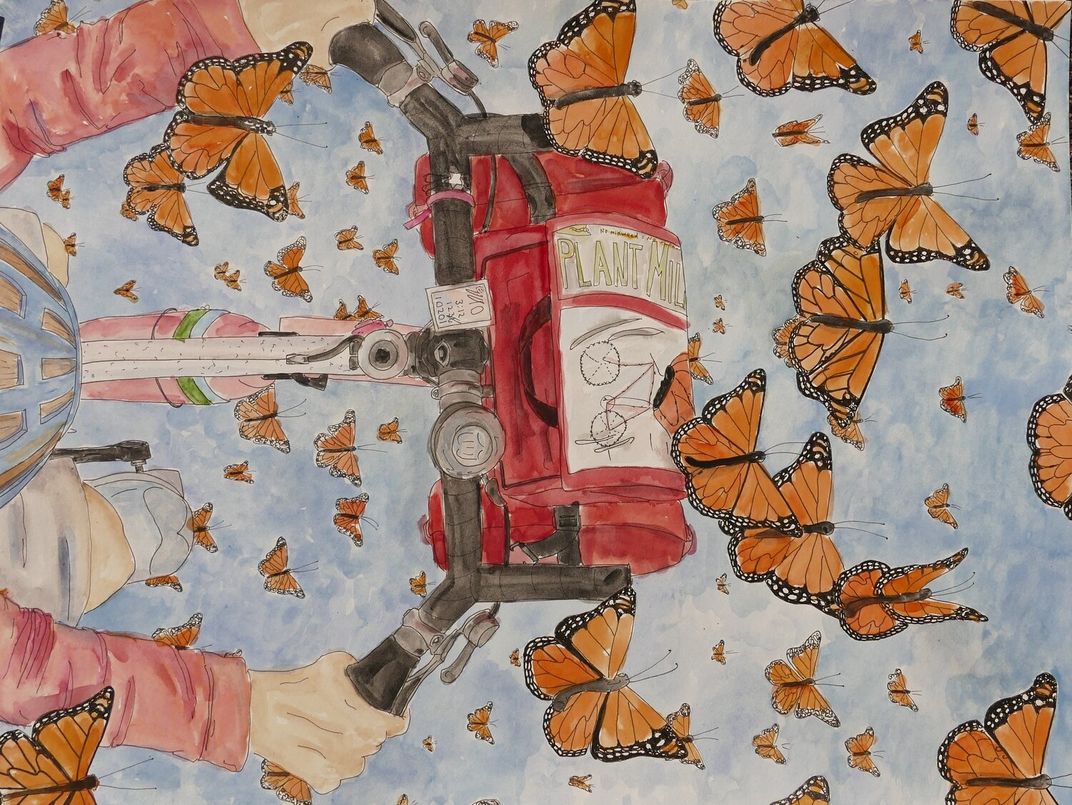
Training
Doubt is as much of an adversary on a long trip as tired muscles are. However, just as legs can be conditioned to carry one farther, a mind can be conditioned, too. The key, at least for me, was to ignore the big picture. Never project thousands of miles into the future. Instead, think about the next mile, the next town, or (best of all) the next meal. In this way, I could confront small distances, and celebrate strings of tiny victories that would soon add up.
I knew this strategy because I was not on my first long trip. I reminded myself that ever since I had been biking, even as a child making laps around the block, I had been proving to myself that I could go the distance. Laps around the block, then the neighborhood, then the city, trained me for my first bicycle tour when I was 17. That tour, a month of 40-mile days up the East Coast, taught me a useful truth: a long trip is nothing more than a collection of miles. If I could bike one mile, then I could bike two. If I could bike two, then I could bike 10,000.
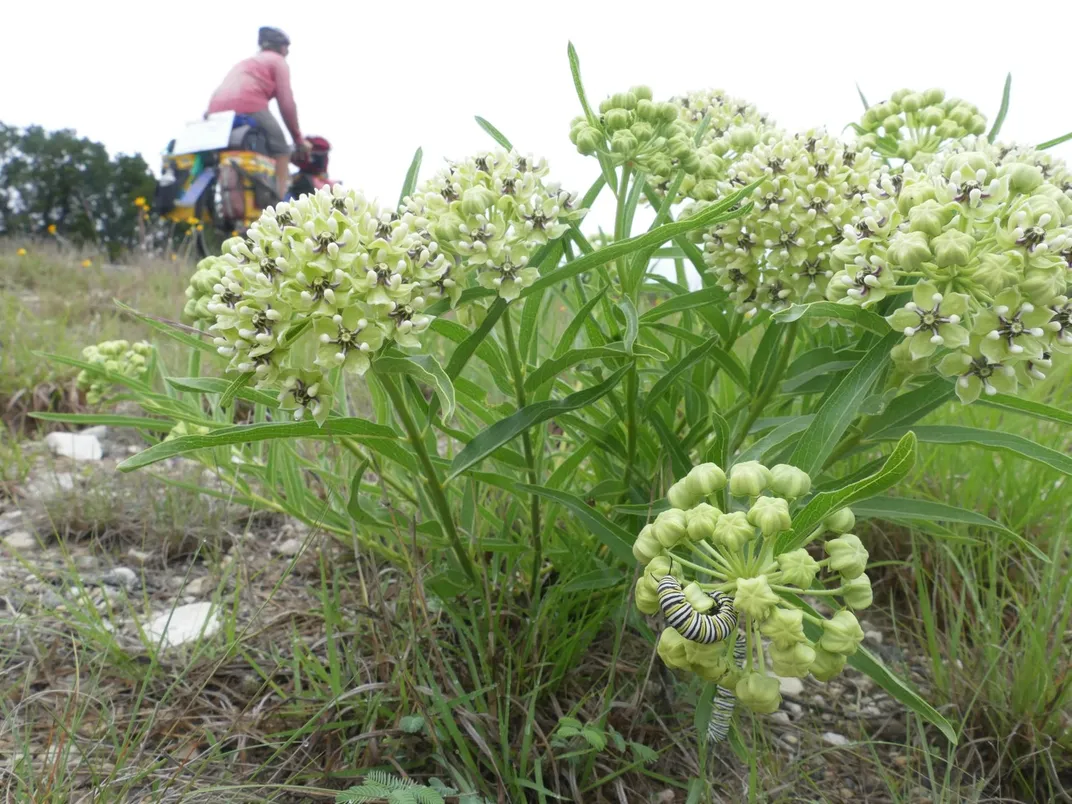
I had already pedaled thousands of miles, including a 12-country bicycle trip from Bolivia to Texas and a 49-state tour around the United States. What these trips had in common was the sense of impossibility that lingered at the start. Before each trip, people told me my dream was not attainable, that I would probably die. Before each trip, I worried that I would fail. But by continuing, I had proved each time that a mile is a mile, regardless of how many are strung together.
Supplies
I loaded down my beater bike, a 1989 Specialized Hardrock, until it was so heavy I could barely lift it off the ground. A Frankenstein bike that I had made five years earlier from a collection of used parts, it looked like a cross between a salvage yard and a garage sale. Its white and pink paint job was speckled with rust-colored dings—scars from past adventures. The bike was ugly. To me, however, it was a reliable machine, a deterrent to theft, a statement against consumerism, and my ticket to adventure. I liked the look.
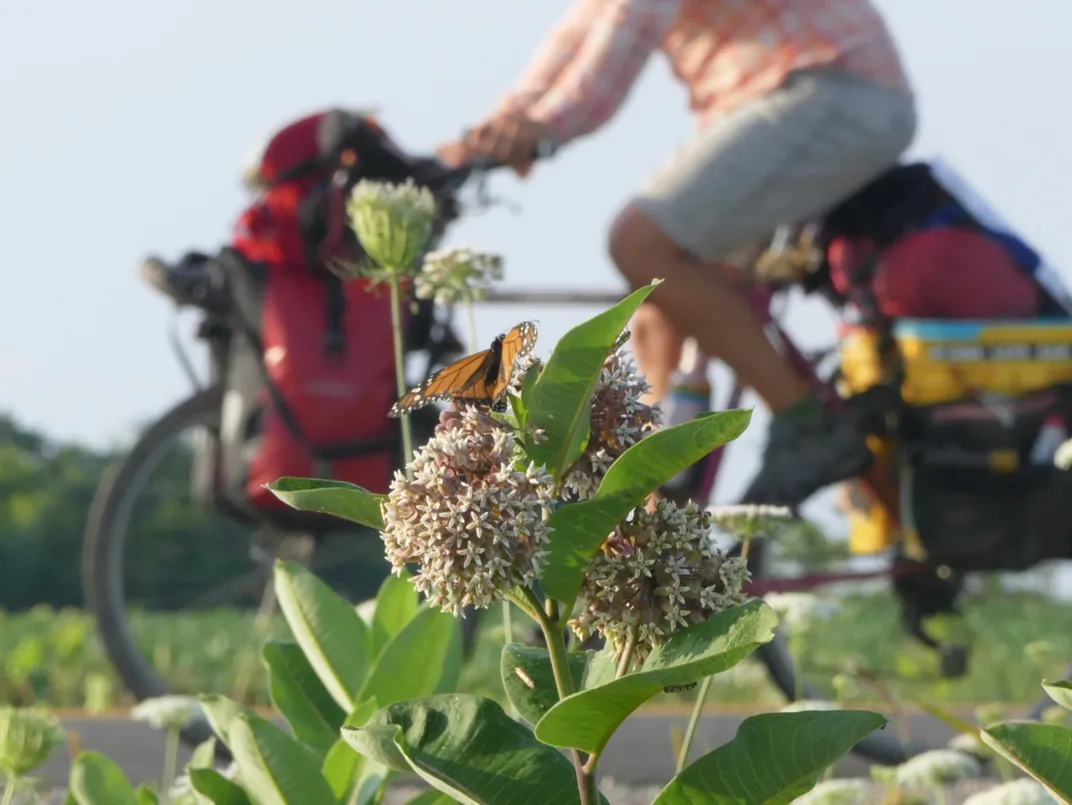
Stuffed into the bags that were clipped, tied, and fastened to my bike was a collection of gear, old and new, that I needed to make the trip. Over my rear wheel, a rack held two cat litter containers I had turned into homemade bike panniers. Those buckets contained a fleece jacket, raingear, a pack towel, shower supplies, tools for minor repairs, a watercolor set, two cooking pots, one homemade stove, one day’s worth of food, a bike lock, and a large water bottle. On top of the buckets were my tent, a folding chair, and a tripod, all held in place by bungee cords and a sign announcing my route and website. One side of the sign was in English, the other in Spanish.
A rack over the front wheel held two store-bought red panniers. One contained my sleeping bag, journal, book, and headlamp; the other, my rolled-up air mattress, laptop computer, and charging devices. On my handlebars was a small bag, stuffed with my camera, phone, wallet, passport, maps, sunscreen, toothbrush, spoon, and pocketknife. It all added up to something around 70 pounds. In contrast, each monarch weighed half a gram. It takes about four monarchs to equal the weight of a dime. Though people gasped when I told them what I was doing, it seemed to me that the monarchs, with their unburdened wings, deserved the accolades. They were much better-equipped adventurers than me.
Route
I figured I would need to bicycle around 10,000 miles if I wanted to go from the overwintering grounds in Mexico to Canada and back. If I left in March, I could get to Canada by summertime and be back in Mexico by November, just like the monarchs. That translated to a very plausible 1,200 miles a month.

Making my trip even more plausible was the biology of the monarchs. While individual monarchs can travel impressive distances in a day, with one monarch having been recorded flying 265 miles in a day, as a whole, the migration advances an average of 25 to 30 miles a day. A cyclist can cover similar distances. Spreading out in the millions across a landscape traced with roads, there were few route-planning limitations. At home in backyards, school gardens, parks, roadside ditches and the wildest places, monarchs, like clouds, are democratic in their reach. Following them by bike seemed meant to be.
On November 30th—264 days and 10,201 miles later —I arrived back at the start. I was not surprised that I was nearly a month behind the majority of the returning monarchs. Though I traveled about 60 miles a day, I had long since learned that I was slower than a butterfly (at least I’m faster than a caterpillar, I told myself). I had also long since learned that though I was following the monarchs, finding them was not the most important part. What was more important was to find the people that could plant milkweed, restore habitat and help the monarchs. In fact, I didn’t see monarchs daily, but every day, every person I saw could, and can, help save the migration.
Adapted from Bicycling with Butterflies Copyright 2021 by Sara Dykman. Published by Timber Press, Portland, OR. Used by permission of the publisher. All rights reserved.
A Note to our Readers
Smithsonian magazine participates in affiliate link advertising programs. If you purchase an item through these links, we receive a commission.
/https://tf-cmsv2-smithsonianmag-media.s3.amazonaws.com/filer/2b/09/2b094de8-864c-457b-bb63-a1fa77b32071/biking_with_butterflies-mobile.jpg)
/https://tf-cmsv2-smithsonianmag-media.s3.amazonaws.com/filer/16/f2/16f2145d-668e-402d-b457-05ba44854c5e/biking_with_butterflies-social.jpg)
